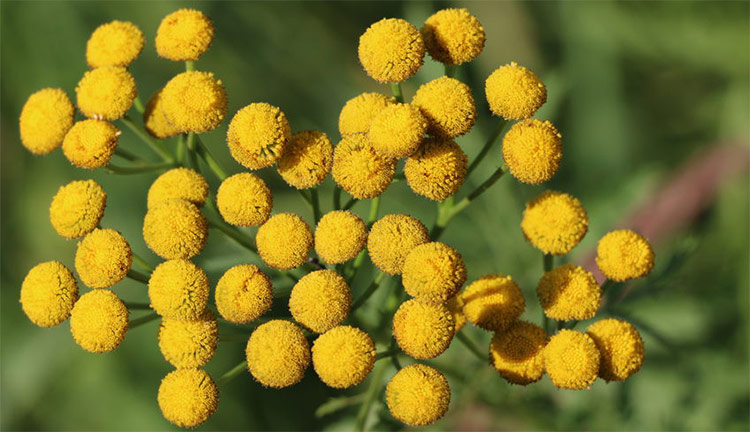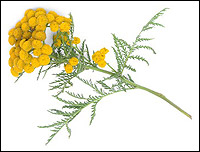Blue Tansy Essential Oil
Tanacetum annuum

Description
The botanical Tanacetum annuum is used to produce Blue Tansy Essential Oil. The photographs depicted on this page reflect the appearance of the botanical Tanacetum vulgare, not Tanacetum annuum. The physical appearance of both botanicals is similar but not identical.
Blue Tansy Essential Oil is sometimes known as Moroccan Chamomile or Moroccan Tansy. The true oil can be hard to acquire and is frequently adulterated. It's very important that you ensure that you are purchasing from a reputable supplier. Be sure that you are obtaining an oil that is specifically distilled from Tanacetum annuum. Tansy (Tanacetum vulgare) and Blue Tansy (Tanacetum annuum) oils are very different oils.

Blue Tansy Essential Oil is recommended by Dr. Kurt Schnaubelt and other holistic aromatherapy experts for its use as a powerful anti-inflammatory and for its anti-histamine, anti-allergen and anti-fungal applications.

Due to its chamazulene content, Blue Tansy Essential Oil is very dark blue in color. Aromatically, Blue Tansy Essential Oil possesses a complex, sweet, slightly floral aroma with camphorous and herbaceous undertones. I find the aroma pleasant, calming and refreshing.
See the "Benefits and Uses" section below for additional information.
Blue Tansy Essential Oil Benefits and Uses
Anti-inflammatory, anti-histamine, anti-allergen and anti-fungal applications including but not limited to the following:
- Asthma
- Muscular Aches
- Eczema
Sources: Neryls Purchon and Lora Cantele, Complete Aromatherapy & Essential Oils Handbook for Everyday Wellness (Toronto ON: Robert Rose, 2014), 111. Jeanne Rose, 375 Essential Oils and Hydrosols (Berkeley, CA: Frog, Ltd, 1999), 52. Kurt Schnaubelt, Ph.D., The Healing Intelligence of Essential Oils (Toronto ON: Healing Arts Press, 2011), 52. Kurt Schnaubelt, Ph.D., Advanced Aromatherapy ( Rochester, VT: Healing Arts Press, 1995), 80.
Botanical Name
Plant Family
Common Method of Extraction
Steam Distilled
Plant Part Typically Used
Flowers/Buds and Sometimes Leaves
Color
Deep Blue
Consistency
Medium
Perfumery Note
Middle
Strength of Initial Aroma
Medium
Aromatic Description
Blue Tansy Essential Oil smells sweet and fruity and possesses subtle floral, camphorous and herbaceous undertones.
Major Constituents
- Chamazulene
- B-Myrcene
- Camphor
- Sabinene
- B-Eudesmol
- 3,6-Dihydrochamazulene
- B-Pinene
- a-Phellandrene
See Essential Oil Safety for a more complete list of typical constituents.
Source: B.M. Lawrence, Progress in Essential Oils. (Perfumer & Flavorist 26 no. 1, 2001), 48-51. Source cited in Robert Tisserand and Rodney Young, Essential Oil Safety (Second Edition. United Kingdom: Churchill Livingstone Elsevier, 2014), 224.
Blue Tansy Essential Oil Safety Information
Tisserand and Young caution that a drug interaction may occur with Blue Tansy Oil when using drugs metabolized by CYP2D6. Reading Tisserand and Young's full profile is recommended. [Robert Tisserand and Rodney Young, Essential Oil Safety (Second Edition. United Kingdom: Churchill Livingstone Elsevier, 2014), 438-439.]
Tansy Oil is different from Blue Tansy Oil. Tansy Oil is high in B-Thujone and poses a hazard for neurotoxicity.
General Safety Information
Do not take any oils internally and do not apply undiluted essential oils, absolutes, CO2s or other concentrated essences onto the skin without advanced essential oil knowledge or consultation from a qualified aromatherapy practitioner. For general dilution information, read AromaWeb's Guide to Diluting Essential Oils. If you are pregnant, epileptic, have liver damage, have cancer, or have any other medical problem, use oils only under the proper guidance of a qualified aromatherapy practitioner. Use extreme caution when using oils with children and be sure to first read the recommended dilution ratios for children. Consult a qualified aromatherapy practitioner before using oils with children, the elderly, if you have medical issues or are taking medications. Before using this or any essential oil, carefully read AromaWeb's Essential Oil Safety Information page. For in-depth information on oil safety issues, read Essential Oil Safety by Robert Tisserand and Rodney Young.
Shelf Life
Important Information About the Profiles
The essential oil information provided on AromaWeb is intended for basic educational purposes only. The references to safety information, test results, constituents and percentages is generalized information. Essential oils can vary greatly in composition. The data is not necessary complete and is not guaranteed to be accurate. The essential oil photos are intended to represent the typical and approximate color of each essential oil. However, essential oil composition and color can vary based on harvesting, distillation, age of the essential oil and other factors. Profiles for several CO2 Extracts and absolutes are included within the directory, and are denoted as such.
